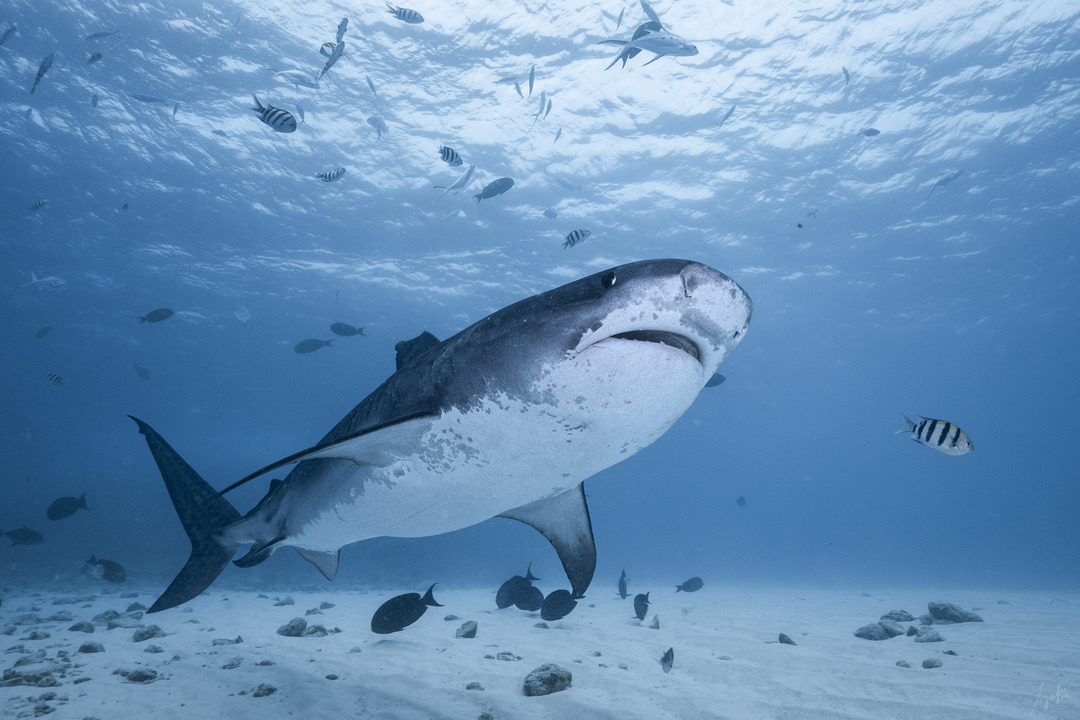
Behavior of Tiger Sharks (Galeocerdo cuvier)
Sharing is caring!
Published on 25 Sep, 2025

Tiger sharks are opportunistic apex predators with one of the broadest diets of any shark. Studies show they exploit a wide variety of prey, including invertebrates, bony fishes, sea turtles, marine mammals, sea snakes, seabirds, and even other sharks. This extremely diverse menu has earned them nicknames like the “garbage cans of the sea,” as they have been found with inedible man-made objects in their stomachs. Tiger sharks will readily scavenge carrion in addition to active hunting. In one remarkable observation, several tiger sharks gathered with oceanic whitetip sharks to feed on a decayed whale carcass, sharing the food peacefully for hours with no signs of aggression among them larger individuals dominated the carcass while smaller sharks hung back for scraps, suggesting a temporary feeding hierarchy instead of chaotic competition.
Territoriality
Tiger sharks are highly nomadic and do not defend strict territories in the way some animals do. Tracking studies indicate they have large home ranges and roam widely across various habitats. For example, tiger sharks in the Bahamas were found to occupy an area over 8,500 km² and still ranged far beyond, with some making long-distance migrations up to 3,500 km into the open Atlantic (eurekalert.org). They tend to revisit productive feeding areas but are not tied to one locale; their movements often depend on prey availability and season rather than territorial boundaries. Notably, certain locations do host seasonal aggregations. At Tiger Beach in the Bahamas, large female tiger sharks regularly gather during the cooler winter months. Researchers hypothesize this site fidelity could relate to mating dynamics (females avoiding aggressive males), rich food resources, or the benefits of warmer shallow waters for gestation. In general, however, tiger sharks exhibit fission-fusion social dynamics, they might associate loosely when conditions favor it, but individuals come and go over time. Even when multiple tiger sharks share space, outright aggression is uncommon. Field studies have also noted that multiple large tiger sharks can co-occur with minimal conflict, with dominance usually established by size rather than violent fights.
Aggregation In Fuvahmulah Island, Maldives

Fuvahmulah has been globally renowned for consistent tiger shark encounters year-round. Unlike most sites where sightings are seasonal, Fuvahmulah offers a rare opportunity to observe large individuals daily. Local dive professionals have recorded over 200 identified sharks, primarily large females, frequently patrolling nearshore drop-offs and deep reef slopes.
Key observed patterns in Fuvahmulah include:
- Site fidelity: Many tiger sharks exhibit recurring appearances in specific zones near the harbor and cleaning stations.
- Non-aggressive curiosity: Despite their size and reputation, the sharks often show slow, investigative passes around divers without signs of aggression.
- Diurnal presence: Sharks are frequently encountered during daylight hours suggesting the area functions as a resting or transit zone rather than an active hunting ground.
These behaviors suggest Fuvahmulah is a non-feeding, low-threat aggregation site, likely serving as part of a larger migratory circuit within the Indian Ocean. The regular presence of gravid females hints at potential reproductive significance, although further research is needed.
Tags
Recent Articles
-
 Showcasing the Maldives’ Wildest Dive Destination at DEMA SHOW 2025Story Dec 16, 2025
Showcasing the Maldives’ Wildest Dive Destination at DEMA SHOW 2025Story Dec 16, 2025 -
 Fuvahmulah Unveiled: The Maldives’ Best-Kept SecretIsland Experiences Dec 16, 2025
Fuvahmulah Unveiled: The Maldives’ Best-Kept SecretIsland Experiences Dec 16, 2025 -
 Introducing Our Resident Marine Biologist: Kelsey OgrenStory Dec 15, 2025
Introducing Our Resident Marine Biologist: Kelsey OgrenStory Dec 15, 2025 -
 Highly Recommended Restaurants in Fuvahmulah – Our Personal FavoritesStory Dec 11, 2025
Highly Recommended Restaurants in Fuvahmulah – Our Personal FavoritesStory Dec 11, 2025 -
